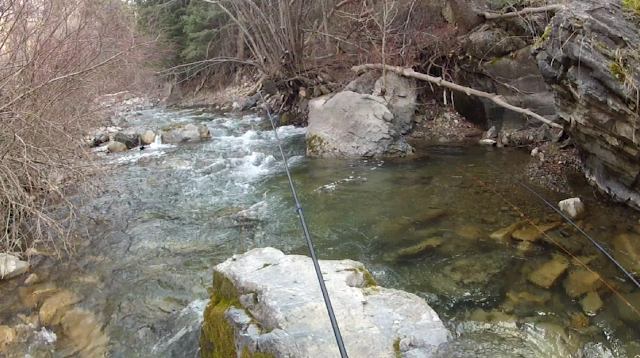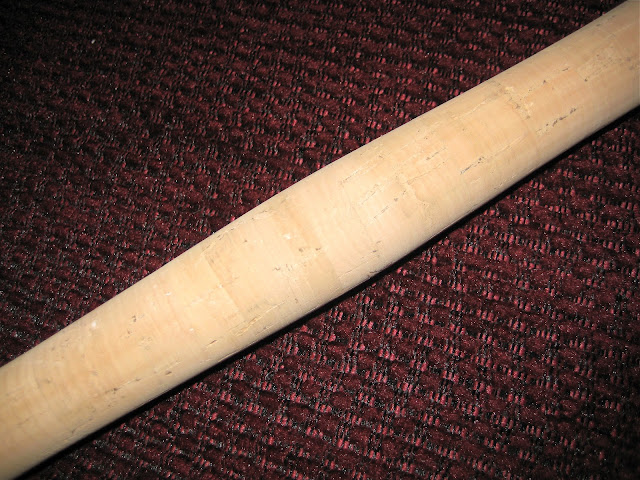I have purchased and fished a small arsenal of Tenkara rods over the past few months. The most recent is the
Tenkara USA Ito. I also have two other excellent Tenkara USA rods:
Iwana-12
and
Amago. In addition to these I have an Allfishingbuy.com
Kasugo-4209. I have fished all of these on the same water, with the same lines, and used the same flies and techniques. It is from my
experience with these rods that I am basing my review of the Ito. These other rods are fixed length rods; the Ito is my first "zoom" or variable length rod.
I purchased my Ito directly from Tenkara USA. The rod cost $235.95 plus shipping. I
ordered it on March 3rd and received it on March 9th. It came in a long, rectangular box via the USPS. This contrasts with my other Tenkara USA rods which came in crush-resistant triangular mailing tubes.
 |
| Case, sleeve, rod |
The rod comes in a synthetic fabric sleeve, and this in turn in a protective rod tube.
Both the rod tube and sleeve have Tenkara USA and logo on them. The rod tube
is light, well made and dark green in color. Both ends have black rubber screw on caps for easy access. The tube is large enough in diameter that the rod with
EZ-Keepers can easily fit inside. The fabric sleeve is dark blue with a hook and loop closure on one end.
The Ito is a very handsome rod. Its aesthetics are flawless. My rod weighs 118.1 grams without the end plug (measured on my Allen analytical
scale). It is advertised as 116 grams. For comparison, my Amago is 97 grams. My Ito is exactly 156 inches (13ft; 396.2cm) extended in its "unzoomed" configuration. Conversely, it is exactly 175 inches (14ft 7in, 444.5cm) when fully extended or "zoomed". When
collapsed it is 27 inches (68.6 cm) with the end plug. This is just a little long for easy travel, unlike the Iwana-12 or Amago. My Amago is 21 inches collapsed.
 |
| Left to right: Iwana 12', Amago, Ito, Kasugo-4209 |
The Ito is rated a 6:4 "slow" action. The rod
has a faux wood plug in the telescoping end and a black anodized metal screw
cap with logo on the handle butt. The black metal screw cap unscrews easily, and when in place adequately secures the butt end of the rod. This cap has small O-rings attached which grip the second segment firmly. It is this segment that can be extended or "zoomed" for additional length.
 |
| Butt cap with O-rings |
The
cork handle is 12 feet 5/8 inches (32.1cm) in length. The handle has a gentle turning
reminiscent of a
full wells, but with elongated
curves. The cork appears to be of excellent quality with few
filled defects. I would appraise the cork as "
AAAA, FLOR or CG1". My
other Tenkara rods are "AAA or CG2" for comparison. There is a stainless polished winding check as well.
The finish of the Ito is a non-glare graphite. It has dark blue
accents on the ends of the larger segments. The lillian is red and glued to the tip. The first, or handle, segment is marked 14'7" (445cm). The second segment is marked 13' (390cm). To "zoom" the rod you grasp the second segment and pull it away from the handle. There is a slight hesitation at first due to the base of the second segment being held by the O-rings in the butt cap. When the second segment is fully extended the rod is 14 feet 7 inches. Very cleaver! It is two rods in one!
Fishing the Ito is fun. In 13 foot mode it feels better than in the extended mode, but not similar to my 12 foot Iwana, a 6:4 action rod. The Ito is billed as a 6:4 rod but it is noticeably softer or slower in action than the Iwana-12. However, in the 14 foot 7 inches mode it is even more noticeably softer (floppier) in action. I have not fished a 5:5 rod (
as of the date of writing this) but I bet this is what they feel like! When casting in 13 foot mode your strokes are shorter and faster than when in the 14 foot 7 inch mode. In fact, when fully extended, I had to make a conscience effort to slow my strokes and thus make my casts more efficient and effective. Cast too fast with the rod in 14 foot 7 inch mode (which I did quite a few times) and you will dump your tippet into a pile on the water. All in all, the rod casts pretty well in both modes; it dampens relatively quickly, no super wild oscillations although it does have more tip overshoot than the Iwana-12 and Amago. I would not call this overshoot "slop", but it does "noodle" more than the other rods I have used. I used a
Tenkara Bum hand tied Hi-Vis line for testing this rod.
The Ito weights slightly more than the Amago, but to me, in its 13 foot mode, it feels a little lighter. I suspect that this is due to a shift in its cantilever balance point when having two graphite segments in the handle. When the rod is fully extended to 14 foot 7 inches it feels like it is 14 feet 7 inches -- tip heavy. The rod is not very fatiguing after 3 hours of steady fishing however, no matter which length mode it is in.
To test the difference of the
cantilever effect in both the 13 foot and 14 foot 7 inch modes I used a crude tool like I did for the
Kasugo-4209 review. You may want go to that review for details of the tool. Basically I measure the amount of weight it takes to balance the rod tip 30 degrees above horizontal. The fulcrum point is mid-handle. In the 13 foot mode it took 604.1 grams. In the 14 foot 7 inch mode it took 791.4 grams. As a point of comparison, the Amago took 571 grams and the Kasugo-4209 took 446 grams to balance the tip at 30 degrees. Despite the large difference between the Ito and these other rods, the Ito, as I have said, actually feels lighter to me than the Amago. I am not exactly sure why, but it is a testament to the nature of design and balance of this rod.
 |
| Cantilever balance in 13 foot mode |
It has been published elsewhere,
such as on Tenkara Talk, that one ways to use this rod is to cast and fish in the 13 foot mode, but when a fish is hooked extend the rod to 14 feet 7 inches. This can aid in landing the fish. I used this technique and found it works quite well. The method of extending the rod, after hooking a fish, that I found works best for me is that while holding the rod with my right hand (I am right hand dominant) reach up with my left hand and grasp the second segment. Since I already have my right arm extended to keep the rod tip high, I just pull the handle segment straight down. This eliminates the need to push the second segment upwards, but accomplishes the same thing, yet in a quicker and smoother motion.
The rod plays the fish comfortably as well. Most of the fish I caught were 10-12 inches, and the water current was modest. These fish/current speeds put a pronounced curve in the rod. Fighting the fish is easy in either length mode but I preferred to extend the rod to full length. This rod does not have the shaft stiffness of the Amago, still, I bet you could control a good sized fish quite comfortably -- but not as well as the Amago, I venture to guess.
 |
| Average size for the day |
 |
| A little smaller |
 |
| Self portrait with fish on! |
CONCLUSION: The Ito is my favorite Tenkara USA rod. Its versatility, varying action, nice balance and, of course, its aesthetics make it a wonderful addition to any Tenkara fishers arsenal. If you are looking for a rod to answer in almost any situation, I would highly recommend the Tenkara US Ito! It is as close to a perfect Tenkara rod as I have seen so far!
Tenkara USA Ito Overview (* poor, ***** excellent)
Quality of materials *****
Physical Characteristics ***'
Overall ****' (4.4 out of 5 stars)
I have a video of the fish I caught with this rod on my blog entry "
A tough day on the river". You can see some of the fish fighting in the clear water. Take a look, it is pretty fun.
An updated impression of this rod, and other rods I have used can be read HERE.















































